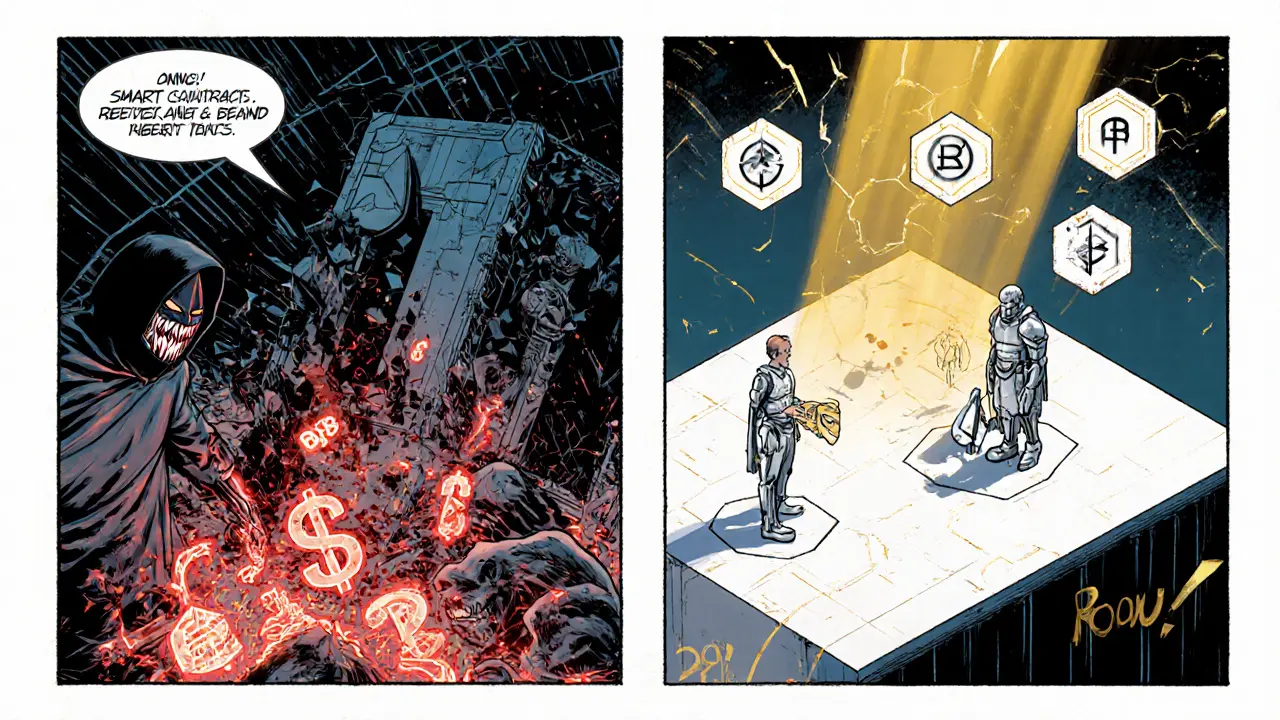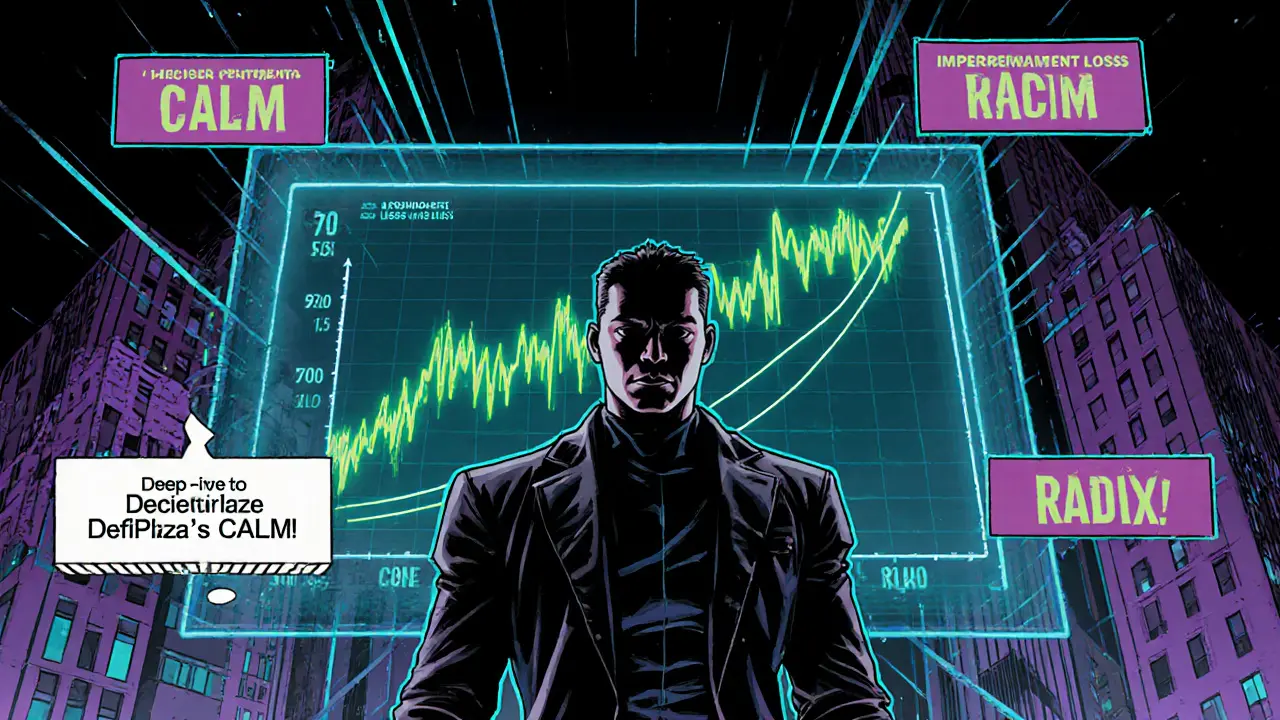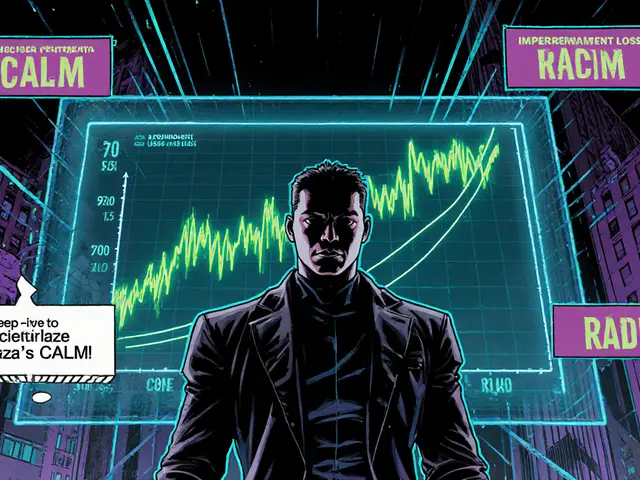DefiPlaza CALM Fee Calculator
Estimate Your Potential Swap Fees
Fee Breakdown:
Quick Take
- DefiPlaza review: innovative AMM that claims to cut Impermanent Loss, now live on Radix.
- CALM algorithm is the core tech, but real‑world volume is under $6K/day.
- Major security breach on Ethereum wiped all liquidity; the team migrated to Radix.
- Low fees, NFT‑based LP tokens, and a 1inch integration are pluses.
- Best for experienced liquidity providers who value IL protection over sheer trading volume.
What is DefiPlaza?
DefiPlaza is a decentralized cryptocurrency exchange (DEX) that operates as an automated market maker (AMM). Its flagship feature is the proprietary CALM algorithm, designed to neutralize the dreaded Impermanent Loss that haunts most liquidity pools.
The platform launched on the Ethereum blockchain in 2022, processed roughly $80million in volume over two years, and then pivoted to the Radix network in 2024 to take advantage of lower fees and faster finality.
How the CALM algorithm tackles Impermanent Loss
Impermanent Loss (IL) occurs when the price ratio of two pooled assets diverges, eroding the value of a liquidity provider’s (LP) share even after accounting for fees. CALM stands for Constant Function Automated Liquidity Management. Instead of treating every swap the same, CALM classifies trades into two buckets:
- Trades that increase IL - these are charged a higher fee that is routed directly back to LPs, offsetting the loss.
- Trades that reduce IL - normal fees apply, and LPs still earn the usual share.
By dynamically adjusting fees based on price impact, CALM aims to keep the net IL close to zero over time. The algorithm’s math is published in a whitepaper and the code is open‑source, allowing anyone to audit the fee curves.
Technical journey: From Ethereum to Radix
The original Ethereum deployment suffered from high gas costs and limited scalability, which conflicted with CALM’s fee‑smoothing goals. After the infamous security breach (see below), the team rewrote the smart contracts for the Radix network, which offers sub‑second finality and near‑zero transaction fees.
On Radix, DefiPlaza lists 37 tokens, including one native stablecoin (XUSDC) and several Radix‑centric assets like XRD, XWBTC, and the platform’s own DFP2 token. Trading pairs are narrow but deep, reflecting the platform’s niche focus on the Radix ecosystem.

The Ethereum security incident
In late 2023, an attacker exploited a flaw in the Ethereum version of DefiPlaza’s smart contracts, draining every liquidity pool. The attack was front‑run by an MEV bot called "Yoink," which paid a 62.5ETH bribe to a Lido validator to seize roughly $24k of the stolen funds. Yoink returned the captured amount within 30minutes after being contacted, but only about 10% of the total loss was ever recovered.
This event wiped out all user funds on Ethereum, damaging trust dramatically. The team responded by conducting a full audit, publishing the findings, and migrating every remaining asset to Radix where the contracts were rebuilt from scratch.
User experience and community feedback
From a trader’s perspective, the UI feels familiar: you select a pair, enter the amount, and hit "Swap." Fees are displayed as a single percentage that already incorporates the CALM adjustment. Liquidity providers, however, have a slightly steeper learning curve. When you add liquidity, you receive an LP NFT that represents your share-these NFTs can be showcased in a wallet or used to claim airdropped XRD tokens.
Community sentiment is mixed. Long‑time DeFi enthusiasts appreciate the IL‑mitigation approach, while newcomers are cautious because of the past exploit and the platform’s modest 24‑hour volume of $5,214.93 (ranked #272 among all exchanges). The integration with the 1inch Network aggregator gives users a shortcut to the best rates across DEXs, but the limited token list still curtails broader adoption.
How DefiPlaza stacks up against other DEXs
| Feature | DefiPlaza | Uniswap V3 | SushiSwap |
|---|---|---|---|
| Core AMM model | CALM (IL‑adjusted fees) | Concentrated Liquidity | Standard Constant Product |
| Primary chain | Radix | Ethereum | Ethereum + BSC |
| Average swap fee | 0.10‑0.30% (dynamic) | 0.05‑0.30% | 0.25% |
| 24‑hr volume (Oct2025) | $5.2K | $1.2B | $480M |
| Impermanent Loss protection | Yes (CALM) | No | No |
| Liquidity‑provider NFTs | Yes | No | No |
DefiPlaza’s niche shines in the “Impermanent Loss protection” row, but its tiny volume and single‑chain focus keep it far from the mainstream traffic that Uniswap or SushiSwap enjoy.
Pros, cons, and ideal user profile
Pros
- CALM algorithm actively reduces IL, making LP positions more predictable.
- Near‑zero gas fees on Radix boost net returns for high‑frequency swaps.
- LP NFTs and occasional XRD airdrops add a gamified layer.
- Open‑source contracts and published audits increase transparency.
Cons
- Security breach on Ethereum still haunts the brand; trust rebuilding is ongoing.
- Low 24‑hour volume limits slippage opportunities for large traders.
- Radix ecosystem concentration narrows token variety; not ideal for cross‑chain arbitrage.
- Complex fee dynamics require a solid grasp of CALM to maximize returns.
Best for
- Experienced liquidity providers who prioritize IL mitigation over raw volume.
- Radix enthusiasts who want a DEX that feels native to the network.
- Developers interested in experimenting with LP‑NFT logic and custom bonding curves.
Future roadmap and upcoming features
The DefiPlaza team has outlined several milestones for 2025‑2026:
- Full WalletConnect integration to broaden wallet support beyond MetaMask.
- Launch of a multi‑token stablecoin pool using bonding curves for ultra‑low‑slippage swaps.
- Expansion of the LaunchPlaza service, offering free staking and token‑burn mechanisms for new Radix projects.
- Deployment of a second‑layer analytics dashboard that visualizes CALM fee adjustments in real‑time.
- Additional security audits and a bug‑bounty program aimed at restoring confidence after the Ethereum exploit.
If these roadmap items materialize, DefiPlaza could transition from a niche IL‑mitigation tool to a core liquidity hub within the Radix DeFi stack.

Frequently Asked Questions
What is the CALM algorithm and how does it differ from Uniswap’s model?
CALM (Constant Function Automated Liquidity Management) adjusts swap fees dynamically based on whether a trade increases or decreases Impermanent Loss. Uniswap V3 uses concentrated liquidity with static fees; it does not actively compensate LPs for IL.
Is DefiPlaza safe after the Ethereum hack?
The Ethereum contracts were fully compromised, but the team relaunched on Radix with new audited code. Ongoing audits and a planned bug‑bounty program aim to mitigate future risks. However, new users should still exercise standard DeFi caution.
How do I become a liquidity provider on DefiPlaza?
Connect a Radix‑compatible wallet, select a pool (e.g., XRD/DFP2), deposit the two assets in the required ratio, and confirm the transaction. You’ll receive an LP NFT that tracks your share and unlocks any future airdrops.
Does DefiPlaza support cross‑chain swaps?
Currently the platform only operates on Radix. A bridge for moving DFP2 between Ethereum and Radix exists, but full cross‑chain automated swaps are not yet available.
Will I earn fees even if Impermanent Loss is neutralized?
Yes. CALM reserves a portion of the higher‑fee trades to compensate LPs, so you still receive a share of fees even when the IL component is offset.



Lisa Stark
February 25 2025DefiPlaza’s attempt to neutralize impermanent loss feels like a philosophical experiment in market design. By adjusting fees dynamically, the protocol invites liquidity providers to think beyond static spreads. The CALM algorithm, while mathematically sound, raises questions about long‑term sustainability in low‑volume environments. Still, the concept pushes the conversation toward more adaptive AMM models.
Shamalama Dee
February 25 2025The CALM fee adjustment is presented clearly in the UI, which helps users see exactly how their trade impacts IL. It’s a good reminder that fee structures can be tools for risk mitigation, not just revenue generators. For newcomers, the balance between simplicity and depth is well‑managed, though a bit more tutorial material could smooth the onboarding curve.
scott bell
February 25 2025Imagine watching a swap and suddenly the fee spikes because the trade would push the price away-boom! That's CALM in action, a bit like a drama where the hero saves the day by paying a higher ticket. It forces traders to respect the pool’s equilibrium, even if you have to sacrifice a few basis points.
vincent gaytano
February 25 2025Oh great, another “revolutionary” algorithm that promises to fix everything while the devs hide behind buzzwords. Let them tell us how the 62.5 ETH bribe was just a typo and the security breach was “just a learning experience”. Sure, because what the DeFi world really needs is more “innovation” after a hack.
Dyeshanae Navarro
February 25 2025CALM tries to make loss less scary for people who put money in pools. It changes fees so you get back some of what you might lose if prices move. The idea is simple and could help more folks feel safe.
Matt Potter
February 25 2025DefiPlaza is crushing the old AMM model! Those dynamic fees are a game‑changer and the Radix move slashes costs, giving us massive returns. Anyone still doubting it needs to step up and join the liquidity rush now.
Marli Ramos
February 26 2025lol defiplaza lookin cool 😂
Christina Lombardi-Somaschini
February 26 2025In the broader context of decentralized finance, the CALM algorithm represents a noteworthy departure from the static fee structures that have dominated the market for years; it introduces a dynamic component that reacts to impermanent loss pressures, thereby aligning incentives more closely with the long‑term health of the liquidity pool. The design philosophy, as outlined in the whitepaper, emphasizes transparency and auditability, qualities that are often proclaimed yet seldom delivered within the ecosystem. By classifying trades into those that increase IL and those that reduce it, CALM creates a bifurcated fee schedule that, in theory, compensates providers precisely when they are most vulnerable to adverse price movements. This targeted compensation mechanism is reminiscent of insurance products, albeit executed through on‑chain smart contracts without a central underwriter. Moreover, the migration to the Radix network addresses the notorious gas fee bottleneck that has plagued Ethereum‑based AMMs, offering near‑zero transaction costs and sub‑second finality, features that are indispensable for high‑frequency arbitrageurs. The low‑volume reality of DefiPlaza, however, raises legitimate concerns regarding slippage and the statistical significance of the fee adjustments, especially for larger trades that could disproportionately affect the pool’s balance. From a user experience perspective, the interface presents the adjusted fee as a single figure, simplifying decision‑making for traders who might otherwise be overwhelmed by complex fee curves. Nonetheless, the underlying mathematics remain accessible only to those with a solid grasp of financial engineering, potentially alienating casual participants. The inclusion of LP NFTs adds a gamified layer to liquidity provision, granting visual representation of one’s share and the possibility of future airdrops, an incentive structure that aligns with contemporary tokenomics trends. Security, of course, remains a paramount consideration; the prior Ethereum exploit underscores the necessity of rigorous audits, and the team’s commitment to ongoing bug bounty programs is a positive signal. While the CALM algorithm’s theoretical foundation is sound, empirical data from the Radix deployment will ultimately determine its efficacy and adoption potential. In sum, DefiPlaza’s approach marries innovative fee dynamics with low‑cost infrastructure, positioning it as a niche but promising contender within the DeFi landscape. Future roadmap items, such as multi‑token stablecoin pools and enhanced analytics dashboards, could further solidify its utility and attract a broader user base. Observers should monitor the platform’s volume growth and community sentiment closely, as these will be critical indicators of its long‑term viability. Only time will reveal whether CALM can truly redefine impermanent loss management.
katie sears
February 26 2025Christina’s exposition raises several salient points that merit further elaboration, particularly regarding the statistical relevance of fee adjustments in low‑volume pools. While the theoretical underpinnings of CALM are robust, practical implementation hinges on sufficient trading activity to smooth out fee volatility. It would be prudent for the development team to publish granular trade‑by‑trade data, enabling independent verification of the IL mitigation claims. Additionally, the forthcoming multi‑token stablecoin pool could serve as a natural laboratory for stress‑testing the algorithm under diversified asset correlations. A transparent roadmap, coupled with community‑driven governance, may alleviate lingering trust deficits stemming from the earlier security incident. Ultimately, the confluence of dynamic fees, Radix’s performance characteristics, and thoughtful tokenomics could redefine liquidity provision paradigms if executed with rigor.
Gaurav Joshi
February 26 2025The CALM model seems fine but it still depends on enough swaps to work properly. Users should keep an eye on the pool size before committing large amounts.
Kathryn Moore
February 26 2025True, volume drives fee stability.
Christine Wray
February 27 2025DefiPlaza’s niche focus on impermanent loss protection certainly differentiates it from the mainstream DEXs, yet the limited token selection may deter traders seeking broader exposure. The Radix integration does bring performance benefits, but adoption will ultimately be measured by user confidence and sustained liquidity. Community feedback appears cautiously optimistic, suggesting a gradual path toward wider acceptance.
roshan nair
February 27 2025Yo bro, the radic speed is lit-like, sub‑second blazzzing through swaps! Sure, the pool ain’t huge yet, but those LP NFTs are like collectible badges, man. If they keep dishing out XRD airdrops, the community will stick around and hype the vibe. Just watch out for those hidden bugs-typos in the contracts can bite ya hard, you know?
Jay K
February 27 2025Thank you all for the insightful discussion. It is encouraging to see the community dissect both the strengths and the challenges of DefiPlaza. I look forward to the upcoming audits and roadmap milestones, which should clarify the platform’s long‑term prospects. Let us continue to share findings and support one another as the ecosystem evolves.